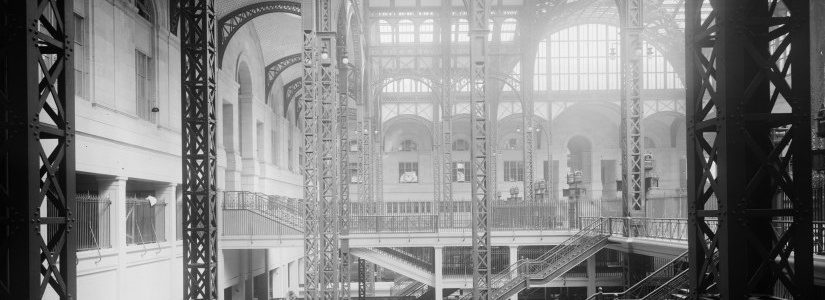Michael Zimmer was one of the young architects who participated in the 1962 picket-line protest of the demolition of Penn Station organized by the Action Group for Better Architecture in New York (AGBANY). Interviewed by Annette Rosen in 2003 as part of the New York Preservation Archive Project’s commemoration of the 40th anniversary of the loss of the station, Zimmer shares his experience as a protestor and his observations on the value of historic architecture.
Our Collections

Michael Zimmer
As a picketer of the Pennsylvania Station demolition, Michael Zimmer tried to rouse public outcry from commuters.
Q: Good evening. Would you please tell me your name?
Zimmer: Michael Zimmer.
Q: Michael Zimmer, how did you get involved in the effort to save Penn [Pennsylvania] Station?
Zimmer: My friends and I were fairly young at this point. I was a graduate of the Harvard School of Design, I had done military service, I had just gotten married, but we thought of ourselves as students of some kind. It’s undignified to say it, but I think the young people went there because we knew Philip Johnson was going to be there. We thought it might advance our careers in some way.
Q: What was your involvement in the effort to save Penn Station?
Zimmer: Distinctly minor. I picketed on that one day when they had all the picket signs. I loved the place, but I’m not sure I noticed it very much—because it was simply there, it was such a wonderful thing. Madison Square Garden was upsetting because they had already torn down the original Madison Square Garden, built by the same architect— who also died on the rooftop of it, shot by Mr. Harry Thaw.
Q: Stanford White, you mean.
Zimmer: Yes. Not the designing partner of the firm, but somehow the most celebrated. It just seemed a shame. What I really remember is the picketing on the sidewalk, and I was grabbing—gently—grabbing commuters heading home on the Long Island Railroad, and they were saying, “What’s this about? We have no time.” I said, “Don’t you want to save this magnificent building?” One of them, standing next to this magnificent granite column, looked up and said, “What building?” Penn Station was so much a fixture in New York. Notwithstanding that poets had written great things about it, it was just there, and it was obviously always going to be there—as demonstrated by the fact that it took three years to tear it down. This was a permanent fixture. Yet, the commuters, maybe less than the travelers who arrived for the grandeur of it—the commuters just saw it as a long walk to the bar and to go downstairs to get on the Long Island Railroad. They certainly didn’t want to talk to us, because they had to catch the 5:15.
Q: How did your involvement shape your future activities after the demolition of Penn Station?
Zimmer: Not very much. We were somehow proud to have taken part in this effort, which we knew to be futile at the time.
Q: Did you get involved in any other preservation efforts?
Zimmer: Not really.
Q: What did you feel the impact of the loss of Penn Station had on New York City and the nation, if any?
Zimmer: My roommate from college, who then became curator of American art at the National Gallery [in Washington D.C.], said, “It’s no great loss on the grounds of architectural redundancy,” because the building across the street—also built by McKim & White—had just as many columns and a lot more stairs. We didn’t really need both of them, facing each other across Eighth Avenue. They didn’t need two Roman buildings.
Q: Redundancy.
Zimmer: Architectural redundancy. It was a whimsical comment, but I, for one, once it was gone, didn’t believe in this random, wanton progress in New York. Those were difficult times, with the Eisenhower stuff, and General Motors putting the streetcars out of business to support the interstate highway system, which was modeled after the Autobahn, so they could get troops from one end of the country to the other. That was a grim time, and that’s the time I went to school. That was [unclear] for architecture, and those were unhappy times. We were doing wanton demolition of the neighborhoods, without any question or concern about the people who lived in them—how they came to be, and why they came to be, and what they were. Every design project was just another blank slate to get money, the way many developers saw Penn Station: as a convenient piece of real estate downtown, [unclear] just as they tried to do with Grand Central.
It’s the same old problem in America. The bottom line is money, and when the bottom line is money you don’t get any quality. You just get people trying to make money.
Q: Mr. Zimmer, we look forward to better times, and thank you very, very much for coming in and speaking with us.
[END OF INTERVIEW]


